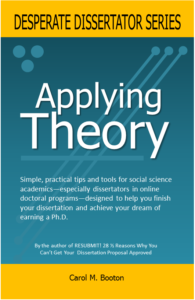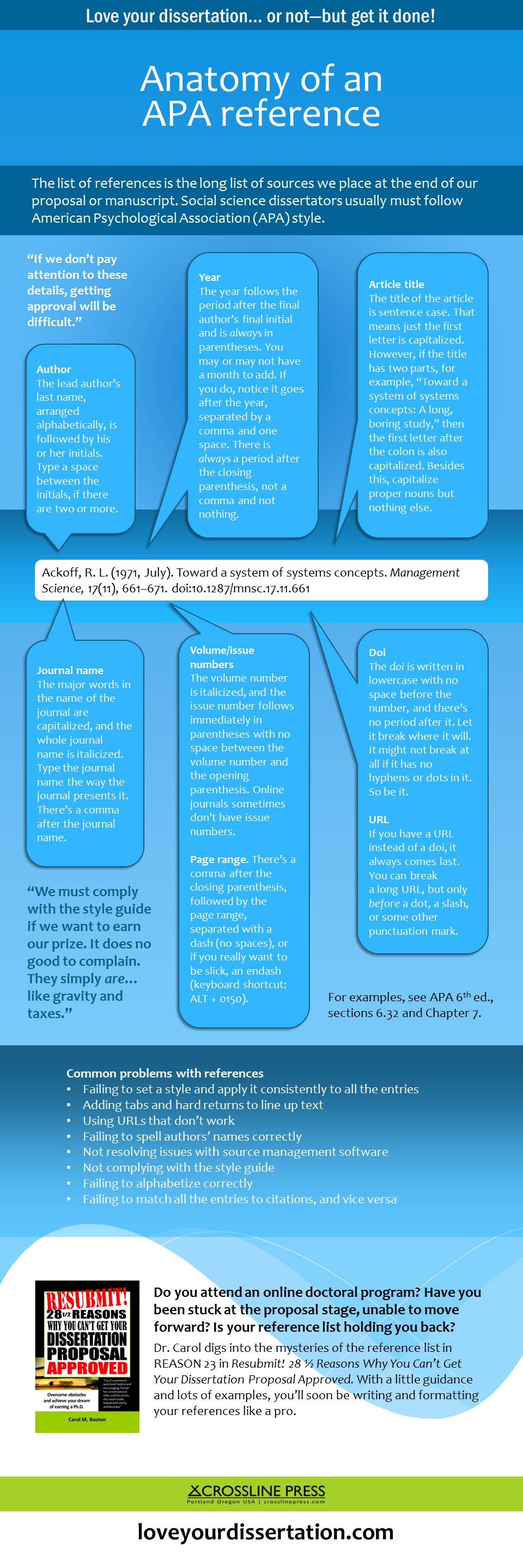Even if you haven’t finished your doctoral research and manuscript—in fact, even if you haven’t started yet—it is not too soon to think strategically about the journal articles that could emerge from your dissertation.
If you attend(ed) a traditional (by traditional I mean a public or private nonprofit) university, you probably already know that you need to publish your research in journals, the sooner (and more reputable) the better.
As a nontraditional dissertator at an online for-profit university, I did not know this. I received no guidance on how to position my research strategically for my future academic career. I now know I was fortunate simply to have a Chair who gave me good feedback and didn’t disappear halfway to the finish line. I’ve since learned, somewhat resentfully, that dissertators at traditional universities often publish articles long before they get to their oral defense.
The dissertation and doctoral degree are not the end of our academic career—they are just the beginning. The dissertation we deliver to the world is a repository of data and knowledge we mine in subsequent months and years to reap the rewards of our long laborious hours of research and writing. No matter what type of institution we attend or attended, we need to publish. But should we convert our dissertation into a book? Journal articles? Or both?
Publish as a book or as a journal article—or both
Printing and binding your dissertation may make it look like a book, but this is not what academic experts mean when they suggest you publish in book form. Publishing your dissertation in book form is an intentional process, planned before you start writing. For example, some traditional dissertators earn degrees in fields in which their dissertations become textbooks. They pitch their projects to publishers long before they start collecting data, sometimes even before their proposals are approved. They plan their projects with their undergraduate audiences (and prospective publishers) in mind.
Intentionally positioning my dissertation as a future textbook never entered my consciousness (and I’m pretty sure it would not have happened unintentionally, given my lack of expertise as a novice researcher). Most of us nontraditional dissertators will struggle through to the finish line and wake up a couple years later wondering what we can do to pummel our dissertation into some sort of shape that could earn us some money to pay back our student loans.
Your dissertation may not translate easily into a book, and that is a topic for another day. However, I have no doubt you can get at least two journal articles from your massive tome, maybe more. Journal articles are typically short, focusing on one aspect of the research study, adhering to a specific structure, and targeting a wider audience than your dissertation would likely reach.
Four steps to publishing a journal article
Four steps: Choose a journal. Figure out the focus of your article. Write it according to the journal’s guidelines, and submit it. Voila. It’s (almost) that simple. Then prepare to wait. Before you start writing a journal article, read all four of my recommended steps, because like a lot of academic writing, this is an iterative process. (That means we often have to run in circles, sweating and grunting and maybe flapping our arms a little bit, before we end up at our destination.)
1. Choose a journal
If you have been at this scholarly thing for a while, you no doubt know thousands of academic journals exist, online and in print. You probably already know some are better than others. Some subscriptions cost a small fortune for a densely written quarterly than can’t bend to fit in your mailbox. Others exist only online, in the Wild, Wild West of academic publishing where anything goes and articles might not even be given issue numbers, let alone volume numbers. Some are in English, some not so much. Some are riddled with typos, formatting faux pas, and unsupported statements that scream not peer-reviewed. You must be careful when you seek prospective journals.
Go back through your dissertation references and make a list of articles that were useful to you. Which seemed the most reputable? Were the authors affiliated with respectable schools? Read what the online world has to say about the journal and its publisher. Look at their websites. Peruse the author submission guidelines. Here’s a hint: If they want you to pay a fee to submit or to publish, strike them from your list of potential journals. You will not be paid for your article, but neither should you pay. Find the journals that have strong peer-review procedures. Aim for top-tier journals in your field, but don’t turn up your nose at second- and third-tier journals. We all start somewhere.
After you have a list of five to ten possible journals, jump to step 2 and find the focuses of your first two articles. Then come back here to step 1 and narrow down your choice to journals that seem like the best fit for your ideas. (Remember, we don’t submit a manuscript to more than one journal at a time.) Start with a top-tier journal. Maybe you will receive a revise-and-resubmit. Awesome! If the reviewers reject your article, revise based on their feedback (if you receive any feedback), and try another journal.
2. Find the focus
I’ve edited a number of life sciences dissertations that were organized into three journal articles, each focused on one aspect of the research project. This format is not the norm in social science fields like business, education, and psychology, in which most dissertators follow a traditional five chapter format. However, if you are required to follow the three-article format, you are home free in the article-submission race. You write your dissertation with the goal of submission in mind, submit your three chapters, and bing bang boom (tech-speak for winning!), you are published.
If not, however, no worries. You can extract at least two articles from your dissertation, no matter what format it follows. The first one will focus on some aspect of the topic. The second will focus on the methodology. Here’s my story.
Topic. My topic was academic quality in for-profit colleges, so logically, my first article focused on that topic. However, when I tried to convert my massive tome to an article, I bogged down to my eyebrows in data. With a firm 7,000-word limit set by the journal I sought, how could I convey the nuances of my findings, plus include a brief introduction, literature review, and list of references? I quickly became overwhelmed.
Finally, after some pondering, I realized that I could report one set of responses regarding one group and draw reasonable conclusions about that one group. Maybe someday I will write about the other groups and themes that emerged. For this first article, I reported what faculty members thought owners and administrators of vocational colleges should do to improve academic quality at their schools. I guess it worked, because after a round of revisions, the article was published by a reputable journal.
Method. My second article, in review now for about a billion years, focused on methodology. In my dissertation, I used rich pictures to gather faculty perceptions of academic quality. I thought, hmm, rich pictures is visually appealing, just the type of research a not-too-fancy online journal might be happy to publish. My submission hasn’t been rejected yet, so we’ll see.
It was hard at first to shift my focus from writing about the conclusions of my research (topic) to writing about the actual process of the research (method), but once I found the angle, I saw other possibilities related to methodology—for example, recruiting hard-to-access participant populations and using web surveys to collect demographic data—that could become future articles.
3. Write the article
Once you have the focus of the article, the rest is just a matter of cramming it all into the format required by the journal to which you plan to submit. Don’t make the mistake of writing your article before you know what journal might accept it. Waste of time. Keep the journal requirements in mind while you write.
Many journals in the social sciences refer authors to the guidelines in the American Psychology Association (APA) Publication Manual. Pay attention to formatting guidelines and word limits. If you have tables and figures, make sure you place them where the journal wants them, with appropriate captions. Be aware of the rules about submitting your name and contact information. (For example, please do not add your name in a running head).
In short, read the journal’s submission requirements and follow them carefully. Don’t give them any reason to reject you before they have had a chance to read your scintillating prose.
4. Submit the article to the journal
Submission usually happens online and involves creating an account with the journal, submitting your Word or pdf file, and then waiting. I hear three months is typical. If you don’t hear something in a month, send an email to the editor, asking for an update.
If you receive an invitation to revise and resubmit, that is great news. You will most likely receive feedback from several reviewers. You can take or leave what they suggest (I suggest you take their suggestions seriously). They will have some valuable questions and insights that will make your work stronger. If something was confusing to them, it will confuse your eventual readers. We don’t want that. So do your best to follow their recommendations. Then resubmit. After a while, you’ll see a proof of your document, with many comments from the publisher’s proofreader, catching the embarrassing typos and citation errors you didn’t.
Eventually, you’ll sign a document giving the publisher the rights to your article, and next thing you know, you’re published. You can add the doi to your CV and email your mom and everything. If you went to a traditional university, you’ve already done this a few times, old news for you, moving on. However, if you went to a nontraditional university, like me, this is a little moment to celebrate before taking a deep breath and doing it all over again. And again.
You can do it
You worked hard on your dissertation… or you are working hard… or you will work hard, if you aren’t done yet. Whatever stage you have achieved in your doctoral journey, you owe it to yourself—you owe it to the world—to bring your findings to the larger community. If you were strategic (and went to the right schools), you likely planned your publishing career before you ever wrote a word of your dissertation. For those of us who are a bit late to the party, don’t worry, we’ll catch up.
================================================
If you are at the proposal stage and running into some obstacles, maybe I can help. Check out my book.

Print version
Kindle version






